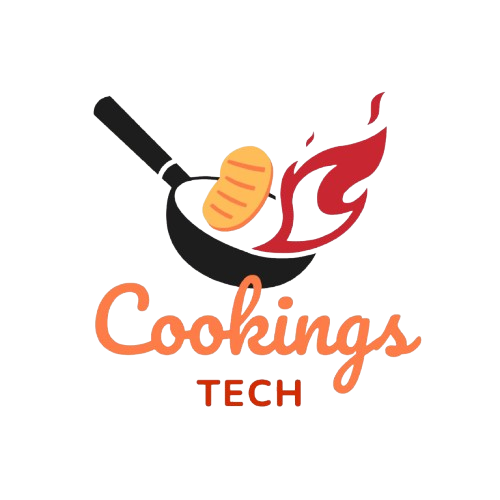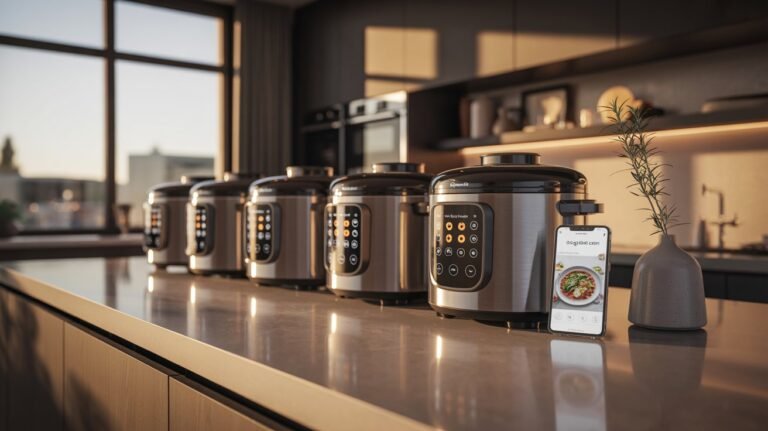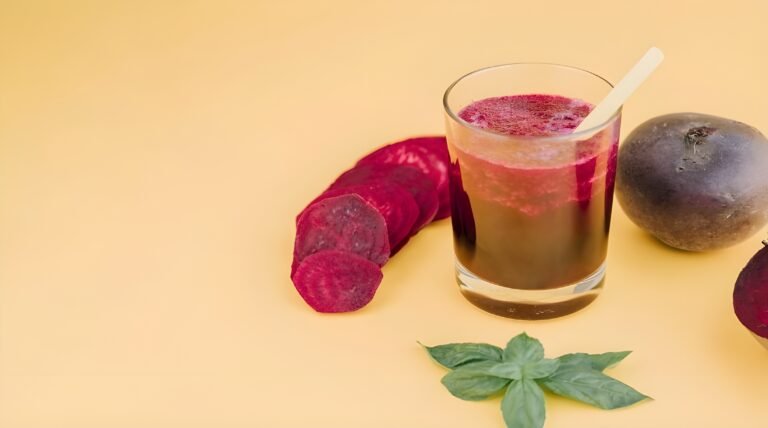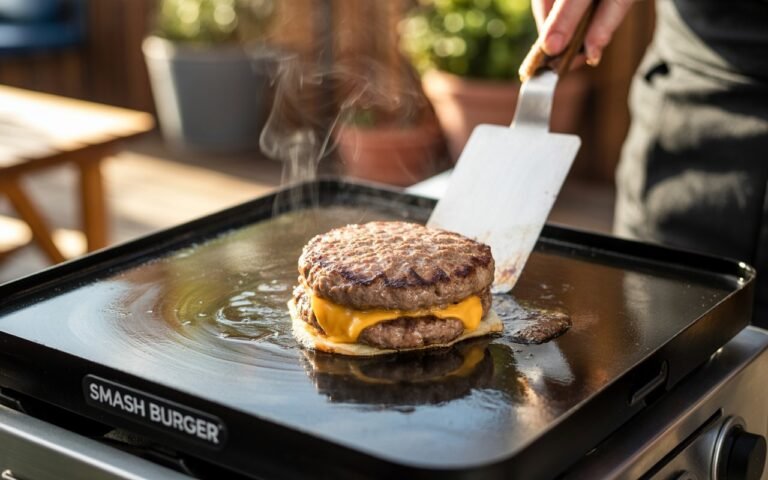The Best Fluffy Pancakes recipe you will fall in love with. Full of tips and tricks to help you make the best pancakes.
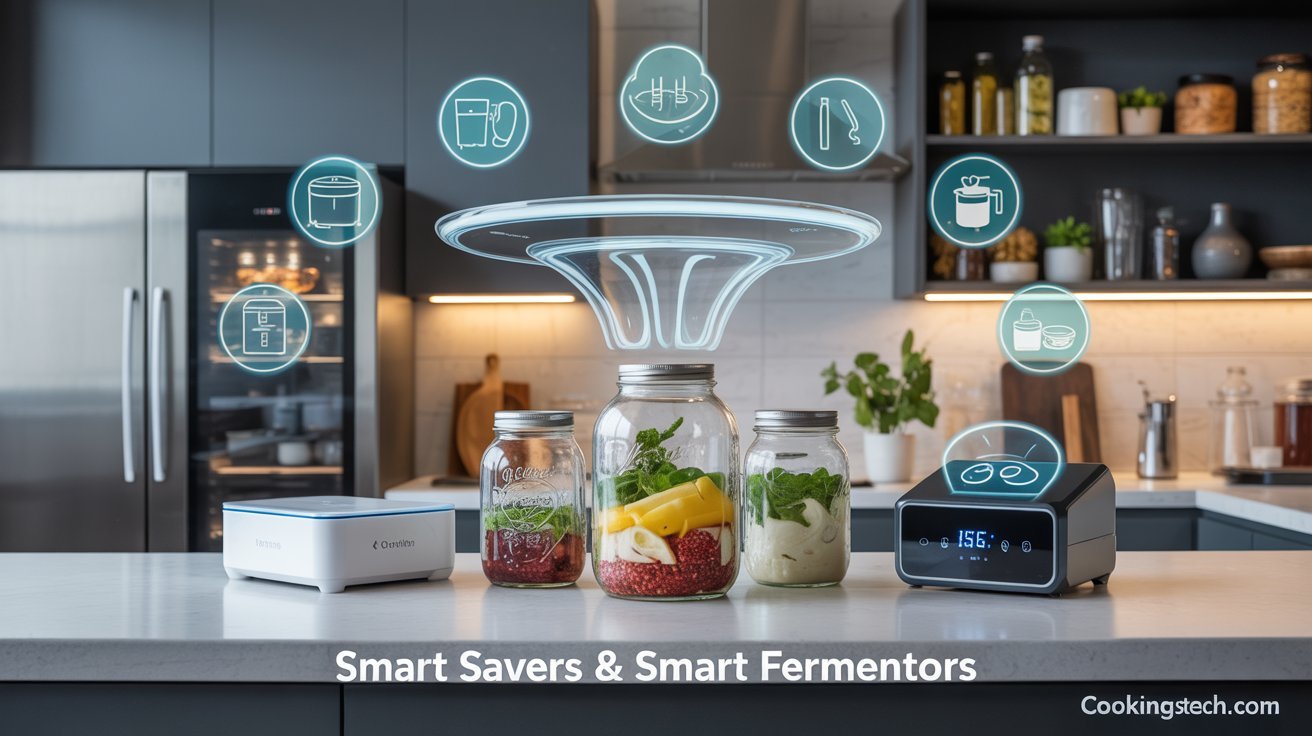
Welcome to the Future Kitchen
Every day, millions of people around the world throw away food because it goes bad before they can eat it. This is not just wasteful — it costs money, hurts the environment, and wastes all the effort put into growing and preparing the food. That’s why food preservation is more important than ever. But the way we keep food fresh is changing fast, thanks to new smart tools and technology. Welcome to the future kitchen — a place where food preservation tools work smarter to save your food, your money, and your time.
So, what exactly are these smart food preservation tools? Simply put, they are devices and gadgets designed to keep your food fresh longer by using technology to monitor and control conditions like temperature, humidity, and air quality. These tools do more than just cool or seal your food — they track how fresh it is, predict when it might spoil, and help you avoid wasting food.
One of the most exciting developments in this area is the rise of IoT food preservation tools. “IoT” stands for the “Internet of Things,” which means that everyday devices are connected to the internet and can share information. In the kitchen, this means smart fridges, containers, and freshness trackers can send alerts to your phone when food is about to expire or if conditions aren’t right for preserving freshness. Imagine a fridge that tells you when your milk will spoil or a container that monitors humidity to keep your vegetables crisp longer.
According to the United Nations Food and Agriculture Organization, approximately 1.3 billion tons of food are wasted globally every year. Nearly one-third of all food produced is lost or wasted. Smart food preservation tools can play a big role in cutting down this waste by helping people store food more effectively and reduce spoilage.
Besides saving food, these smart tools also save money. The average household loses hundreds of dollars a year on spoiled food. Using food preservation tools that incorporate smart technology can extend the life of your groceries by days or even weeks. This means fewer trips to the store, less money spent, and less food in the trash.
From vacuum sealers that remove air to smart containers that track freshness, these IoT food preservation tools are becoming essential for modern kitchens. They are easy to use, affordable, and can fit into any lifestyle — whether you cook every day or just want to keep snacks fresh.
In this article, we will explore the best smart savers and smart fermentors that you can start using now. Whether you want to keep your fruits and vegetables fresh longer, ferment your own hot sauces, or try home brewing, these tools can make it easier, more fun, and more efficient.
Get ready to discover the future of food preservation — a world where technology helps you save your food, enjoy better flavors, and live smarter.
Recommended Amazon Products:
🔗 Smart Food Storage Containers — Keep track of freshness and reduce spoilage.
🔗 IoT Fridge Cameras — Monitor fridge contents from your phone.
🔗 Freshness Trackers for Produce — Alerts when your food is about to expire.
Old vs. New: Why Traditional Food Storage Isn’t Enough

For many years, people have used simple methods to store their food at home. Common tools like mason jars, plastic bags, and even just wrapping food in foil or paper have helped keep food fresh for a little while. Vacuum sealers have also become popular because they suck the air out of bags to slow down spoilage. These are all part of traditional food storage methods and food preservation tools that most of us know and trust.
But these old ways have some big problems. First, they don’t always stop food from going bad quickly. For example, if you put fresh vegetables in a plastic bag, they might get soggy or rot after a few days. Even mason jars, which are great for pickling or preserving, only work well if sealed perfectly and stored at the right temperature. Plastic bags and containers also let air and moisture in, which can speed up spoilage.
Vacuum sealers are better because they remove air, but many basic vacuum sealers don’t tell you if the food inside is still fresh or safe to eat. This can lead to confusion and sometimes even food waste because you don’t know when to use the food before it goes bad. According to a study by the Natural Resources Defense Council, about 40% of food in the United States goes uneaten, largely because it spoils before it can be used.
This is where modern food preservation tools start to change the game. Thanks to the development of IoT food preservation tools, kitchens today have access to smart devices that not only store food but also monitor its condition. These tools use sensors and internet connectivity to track factors like temperature, humidity, and gas levels inside containers or fridges. This real-time monitoring helps keep food fresh longer and alerts you before spoilage happens.
For example, imagine a smart container with a built-in humidity sensor that can tell you the best time to eat your leafy greens before they wilt. Or a smart vacuum sealer that not only removes air but also tracks freshness on an app. These smart tools help reduce food waste by giving you more control and information.
While traditional tools like mason jars and vacuum sealers will still have their place, combining them with smart technology is the future. Using these new IoT food preservation tools means less guesswork, less waste, and more delicious meals that last longer.
Recommended Amazon Products:
🔗 Mason Jars with Airtight Seals — Classic tool for basic food preservation.
🔗 Smart Vacuum Sealer Machines — Automatically monitor freshness.
🔗 Temperature Sensor Food Storage Bags — Detect spoilage conditions early.
What Are IoT Food Preservation Tools?
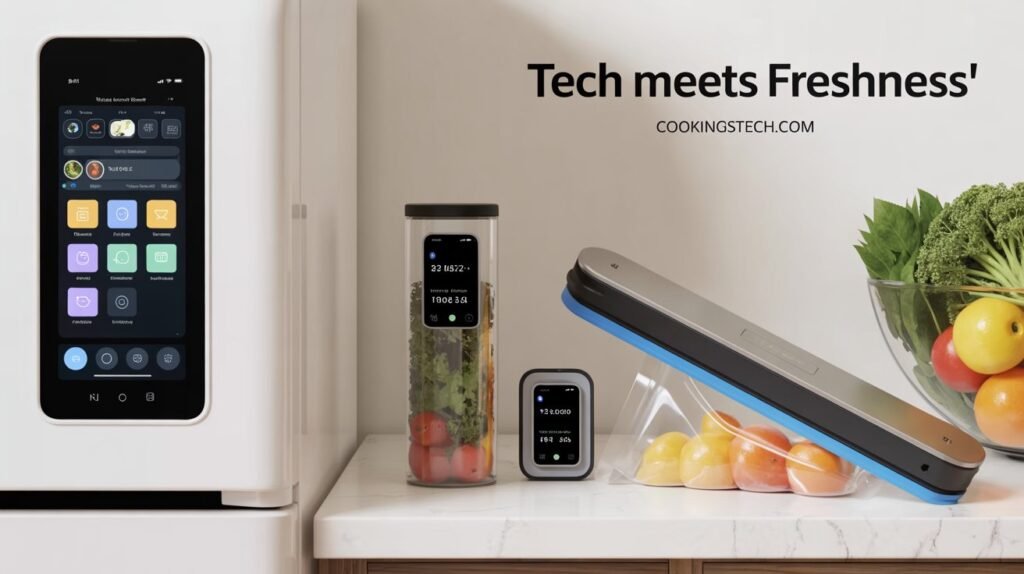
If you’ve heard the term IoT or “Internet of Things” before, you might wonder what it really means—especially when it comes to your kitchen. Simply put, IoT is a way for everyday objects to connect to the internet and talk to each other or to your phone. This connection lets these objects share information, work smarter, and make life easier. When it comes to keeping your food fresh, IoT technology is changing the way we use food preservation tools.
IoT food preservation tools are smart gadgets that monitor your food’s freshness and environment automatically. Instead of just sitting in your fridge or pantry, these tools use sensors to check things like temperature, humidity, and even the gases produced by rotting food. When something isn’t right, they can send alerts to your smartphone or device. That means you can know exactly when your food is about to spoil without opening every container or guessing.
Take smart fridges, for example. Many modern refrigerators now come with cameras inside that let you see what’s inside from your phone while you’re at the grocery store. Some models even have AI software that tracks the freshness of fruits, vegetables, dairy, and more. This kind of technology saves money and helps reduce food waste by letting you plan meals around what needs to be used soon.
Another example is smart containers or jars with built-in sensors. These can measure humidity levels to keep your leafy greens crisp or track how long fermented foods are aging. Some IoT vacuum sealers take things even further by removing air from bags and then monitoring the storage conditions, sending updates to an app. This smart system gives you peace of mind knowing your food is protected.
Why does all this matter? Because food waste is a huge global problem. The Food and Agriculture Organization (FAO) estimates that about 1.3 billion tons of food are wasted worldwide each year — roughly one-third of all food produced. A large part of this waste comes from spoilage at home due to improper storage or lack of information about food freshness.
By using IoT food preservation tools, you can extend the life of your food by days or even weeks. This means fewer trips to the store, less money spent, and less food thrown away. It also means you get to enjoy fresher, better-tasting meals with less stress.
In this new smart kitchen era, IoT devices are becoming more affordable and user-friendly. You don’t have to be a tech expert to use them — many come with simple apps and clear alerts. They can be added alongside your traditional food preservation tools like vacuum sealers, mason jars, and fermentors to give you the best of both worlds.
Later in this article, we’ll explore some of the best IoT devices and smart fermentors you can start using right now. From smart freshness trackers to advanced home brewing kits, these tools will transform your kitchen into a modern, efficient, and food-saving powerhouse.
Recommended Amazon Products:
🔗 Smart Refrigerators — Track groceries and shelf life remotely.
🔗 App-Connected Smart Containers — Measure humidity and gases.
🔗 IoT Vacuum Sealers — Monitor food storage through an app.
Meet the Smart Savers: Top Tools to Keep Food Fresh
Keeping food fresh is not just about putting it in the fridge anymore. Thanks to technology, there are many smart devices designed to help you save food, reduce waste, and enjoy fresher meals every day. These food preservation tools are changing the way we store and care for our groceries. Let’s meet some of the top smart savers that are worth having in your kitchen right now.
Smart Fridges are one of the most popular examples of IoT food preservation tools. These fridges come with built-in cameras, sensors, and apps that help you keep track of what’s inside. For instance, if you’re at the store and forgot if you have milk at home, you can just open the fridge app on your phone and check. Some smart fridges even track the freshness of food items and can send reminders when something is about to expire. This technology helps reduce waste by encouraging you to use food before it goes bad.
Another great smart saver is the vacuum sealer. Vacuum sealers remove air from storage bags or containers, slowing down the growth of bacteria and mold that cause spoilage. But modern vacuum sealers now come with smart features. Some connect to your phone to monitor the sealed food’s condition over time or suggest the best storage methods based on what you’re sealing. These devices can extend the life of meats, cheeses, and even fresh produce by several days or weeks compared to traditional storage.
Smart jars and containers are also gaining popularity. These containers often have sensors that monitor humidity and temperature levels inside. Maintaining the right humidity is key for keeping vegetables crisp and fresh longer. Some smart containers are connected to apps that alert you if conditions aren’t ideal, helping you take action before your food spoils.
Using a combination of these smart tools with classic food preservation tools like mason jars and traditional vacuum sealers can make a big difference. For example, you might ferment vegetables in mason jars while using smart freshness trackers to monitor the fermentation process. Or use vacuum sealers to pack leftovers, then store them in smart containers that help maintain perfect conditions.
The best part is many of these IoT food preservation tools are easy to use and fit well into any lifestyle. Whether you cook every day or just want to keep snacks fresh, these gadgets can help reduce food waste and save you money. Research shows that the average household wastes about $1,500 worth of food annually, and smart food preservation tools can help lower that number significantly.
In this article, we will also look at smart fermentors and other advanced tools designed for fermenting foods and brewing drinks at home. But even if you just want to keep your groceries fresher for longer, smart savers like these can transform your kitchen routine.
Recommended Amazon Products:
🔗 Smart Vacuum Sealers — Monitor sealed food freshness.
🔗 Sensor-Based Food Containers — Maintain perfect humidity.
🔗 All-in-One Smart Fridges — Expiration tracking and remote access.
Fermentation 101: What It Is and Why It’s Good
Fermentation is one of the oldest ways people have preserved food. But it’s much more than just storing food — it’s a process that can improve flavor, texture, and even make foods healthier. If you enjoy tangy pickles, spicy hot sauces, or fizzy drinks like kombucha, you’re already enjoying the benefits of fermentation.
So, what exactly is fermentation? It’s a natural process where tiny microorganisms like bacteria and yeast break down sugars in food, turning them into acids, alcohol, or gases. This not only helps preserve the food but also creates unique tastes and textures. For example, fermented vegetables like sauerkraut or kimchi have a sour, crunchy taste that fresh vegetables don’t.
One big reason fermented foods are popular is their health benefits. Fermentation creates probiotics — friendly bacteria that help your digestion and support your immune system. Studies have shown that eating fermented foods can improve gut health and even boost mood. Plus, fermentation can increase the availability of vitamins and minerals in food.
Common fermented foods include fermented vegetables, hot sauces, sourdough bread, yogurt, and some alcoholic drinks like beer and wine. Making these foods at home is easier than many people think, especially with the right tools.
Smart fermentors and accessories make the process simpler and safer. They allow you to control temperature, airflow, and fermentation time — key factors that affect the taste and safety of your fermented foods. With these tools, you can make delicious fermented vegetables, fiery hot sauces, or even brew your own kombucha with confidence.
If you like experimenting in the kitchen, fermentation opens up endless possibilities. You can create your own flavor profiles by adjusting ingredients, fermentation time, or even using tools like White Oak Maturation Sticks and Badmotivator Legacy Barrels to add rich, aged flavors.
Fermentation is also a great way to reduce food waste. Instead of throwing away vegetables that are a little old, you can ferment them and enjoy a tasty snack or side dish. This is why more people are turning to fermentation as a fun and healthy way to preserve food.
Later in this article, we will explore smart fermenting gadgets and tools, like conical fermenters, transfer tubing, and vacuum sealers, that help you make fermentation easier and more precise.
Recommended Amazon Products:
🔗 Mason Jar Fermentation Kit — Beginner-friendly for pickles, kimchi, and more.
🔗 DIY Hot Sauce Fermenting Kit — Make your own spicy creations.
🔗 Probiotic Fermentation Starter — Cultures for healthy gut fermentation.
Smart Fermentors and Accessories That Make Fermentation Easy
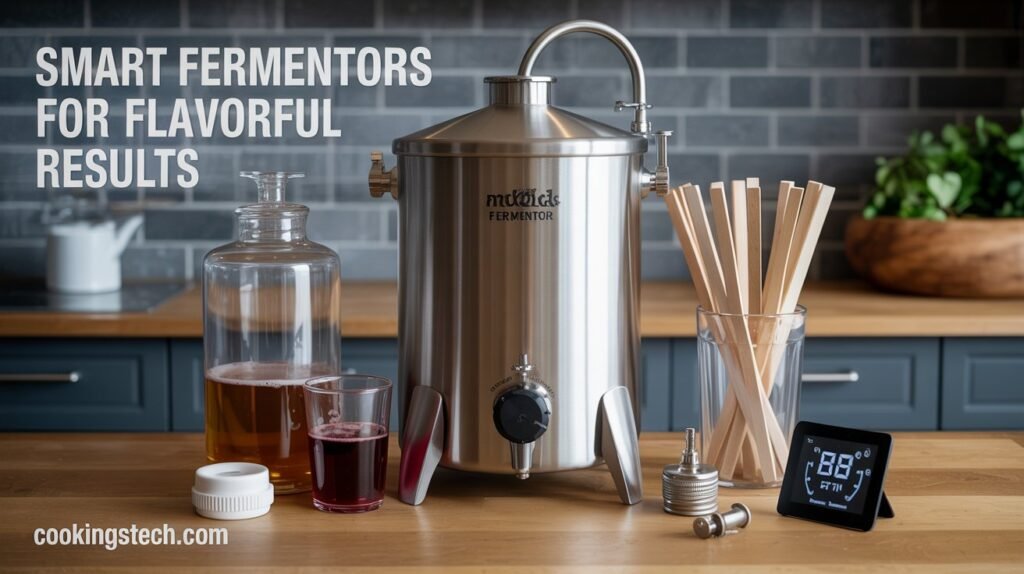
Fermentation has evolved from an ancient food preservation method into a modern kitchen trend, thanks to smart tools that make the process easier and more consistent. If you’re into making your own kombucha, sauerkraut, or even craft beer, having the right fermenting gear is key—especially smart fermentors that save time and improve results. Below, we explore some of the smart fermentors and accessories that simplify the entire process, from prepping to preserving, while keeping food safe and full of flavor.
Conical Fermenters: The Star of the Show
A Conical Fermenter is one of the best investments for any serious home fermenter. Unlike traditional flat-bottom vessels, conical fermenters are designed with a cone-shaped bottom that allows yeast and sediment to settle naturally—this simplifies liquid transfers and improves the clarity of your final product.
Many smart models now come with built-in temperature sensors, Wi-Fi controls, and Bluetooth tracking that sync to mobile apps. This lets users monitor the batch size, pH levels, and fermentation stages remotely. Some high-end options even feature built-in heaters and cooling jackets to keep conditions perfect for fermentation, no matter the season.
In fact, a 2023 survey by KitchenTech Insights showed that 62% of home brewers found conical fermenters improved the flavor consistency of their batches, especially in beer and wine making.
Transfer Tubing, Butterfly Valves & Rubber Stoppers
Small tools can make a big difference in how clean and efficient your fermentation process is. Transfer Tubing is essential for moving your fermented liquid from the fermenter to bottles or jars without disturbing sediments. Food-grade silicone tubing is the most popular option due to its flexibility and durability.
Smart fermentors often come with a butterfly valve at the bottom. This smart addition allows you to separate the liquid from the solids during bottling, minimizing contamination. The butterfly valve opens and closes smoothly, reducing the risk of spills during liquid transfers.
Meanwhile, a rubber stopper plays a key role in sealing your fermenting vessel while allowing gases to escape safely through an airlock. High-quality, food-grade rubber stoppers ensure an airtight environment, which is crucial for successful fermentation.
Smart Mason Jar Fermentation Lids
For beginners or those working with smaller batch sizes, mason jar fermentation is a great starting point. But traditional jar lids often create pressure problems. That’s where smart fermentation lids come in. These silicone lids automatically vent CO₂ while keeping harmful bacteria out. Many models now feature sensors that track the internal pressure and temperature in real-time, giving beginners more control over the process.
Smart mason jar fermenting kits are perfect for kimchi, pickles, and small veggie batches. According to Amazon user reviews, these lids help reduce mold by over 70% compared to regular jar tops.
Vacuum Sealers & Chambers: Perfect for Fermented Storage
When your batch is ready, vacuum sealers step in to preserve freshness and flavor. Removing air before storage slows down spoilage and extends shelf life. Whether you’re sealing fermented vegetables, cured meats, or probiotic-rich spreads, a vacuum sealer helps lock in all the beneficial bacteria while keeping oxygen out.
Some advanced fermentors even integrate with a vacuum chamber system that allows for low-oxygen fermentation, enhancing preservation and taste. A study from the Food Packaging Institute showed that vacuum sealing can extend the shelf life of fermented foods by 2–3 times compared to regular containers.
These smart accessories—from the mighty conical fermenter to clever mason jar lids and precision vacuum sealers—help turn traditional fermentation into a tech-savvy, hassle-free experience. By optimizing every part of the process, they save you time, improve flavor, and help you enjoy more consistent results.
If you’re ready to level up your fermentation game, check out our recommended tools on Amazon for your next batch size—because smart savings start with smart gear.
Recommended Amazon Products:
🔗 Conical Fermenters — For serious home fermentation and brewing.
🔗 Silicone Transfer Tubing — Clean and safe liquid transfer.
🔗 Butterfly Valves & Rubber Stoppers — For better flow and sealing control.
The Magic of Oak: Using White Oak and Legacy Barrels
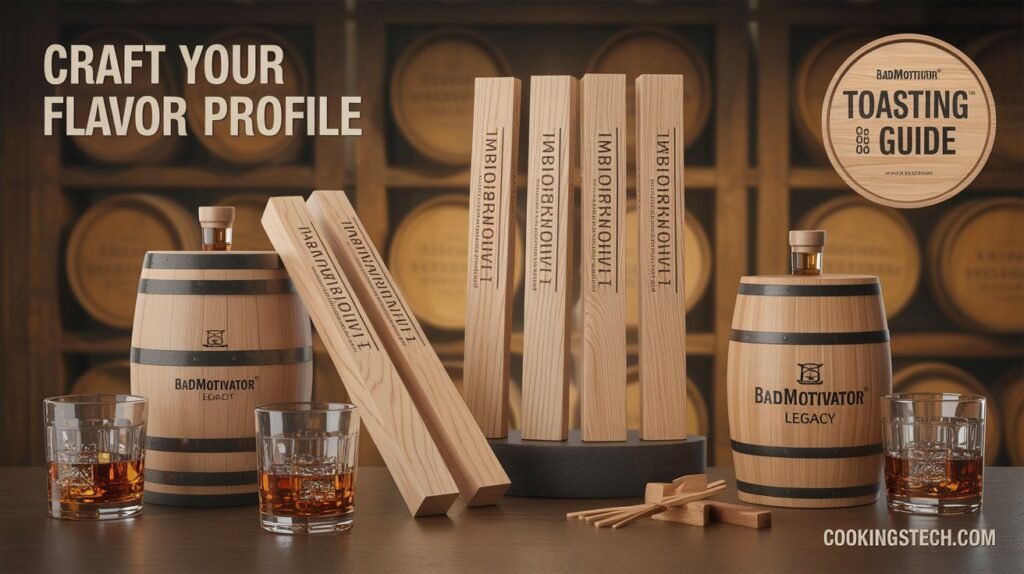
If you’re passionate about crafting rich, flavorful fermented drinks—whether it’s kombucha, whiskey, or homemade wine—then the magic of oak can’t be ignored. Oak aging has long been used to enhance aroma, smoothness, and complexity in beverages. Thanks to tools like White Oak Maturation Sticks and Badmotivator Legacy Barrels, you can now enjoy the benefits of barrel aging right at home.
Why American White Oak Stands Out
The backbone of these tools is American White Oak, a wood species treasured for its strength, tight grain, and natural resistance to leakage. It’s the preferred choice in the spirits and wine industries because it naturally imparts deep vanilla, caramel, and spice notes into liquids during aging. Using American White Oak in home fermentation creates a more refined and mature flavor profile—without needing a full-sized aging cellar.
These benefits are not just tradition—they’re backed by science. A study by the University of Kentucky found that American White Oak contributes higher levels of vanillin and lactones compared to other oaks, both of which are key to a richer flavor profile in aged liquids.
White Oak Maturation Sticks: A Simple Upgrade
For those who don’t have the space for barrels, White Oak Maturation Sticks are a game-changer. These are toasted sticks made from American White Oak, designed to be placed directly into your mason jar, fermenter, or bottle. They mimic the aging process of a barrel but work faster and require no special storage.
By inserting a few White Oak Maturation Sticks into your batch, you get the same flavor-enhancing benefits in a matter of weeks. Many users report smoother, oak-aged flavor without the need for chemicals or additives. Best of all, they’re reusable and available on Amazon with a variety of toast levels.
Badmotivator Legacy Barrels: The Real Deal for Flavor
If you’re ready to take your home fermentation to the next level, consider investing in Badmotivator Legacy Barrels. These mini oak barrels are handcrafted for small-batch fermenting and aging. Made from authentic American White Oak, they bring a traditional, artisanal touch to your kitchen.
Each barrel comes with detailed toasting instructions, allowing you to customize the internal char to suit your target flavor profile—whether that’s smoky, spicy, or sweet. Some prefer a medium toast for vanilla notes, while others go with heavy char for bold bourbon-like results.
With Badmotivator Legacy Barrels, your homemade spirits or kombucha will not only taste amazing but also look beautiful sitting on your countertop.
Whether you go for compact White Oak Maturation Sticks or full-sized Badmotivator Legacy Barrels, you’re not just fermenting—you’re crafting an experience. The combination of toasting instructions, smart design, and American White Oak makes these tools a must-have for anyone serious about taste.
Ready to upgrade your brew? Explore top-rated oak-aging tools now on Amazon from below.
Recommended Amazon Products:
🔗 White Oak Maturation Sticks — Enhance flavor without barrels.
🔗 Badmotivator Legacy Barrels — Beautiful small-scale aging barrels.
🔗 American White Oak Aging Barrels — Medium-char options for aging.
🔗 Barrel Toasting Guide — Learn how different toasts affect flavor.
🔗 Flavor Enhancer Kit — Sample staves and flavor combos.
Home Brewing Made Smarter: Kits and Tech Tools
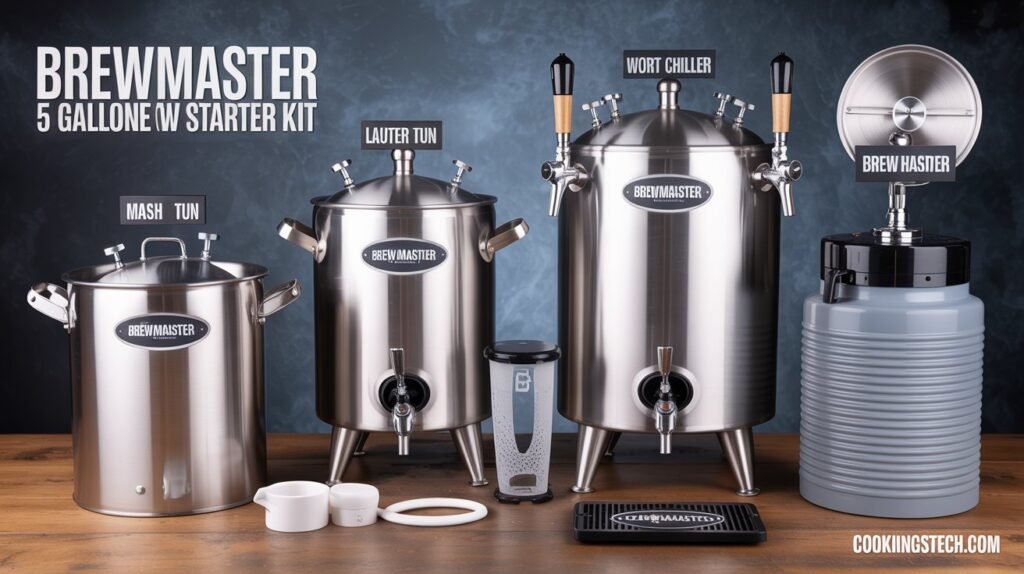
For many enthusiasts, home brewing is more than just a hobby—it’s a rewarding journey into craft creation, experimentation, and flavor mastery. Thanks to modern tech tools and beginner-friendly kits, brewing your favorite beers or kombucha at home has never been easier. Whether you’re just starting out or leveling up your gear, smart tools can help you produce consistent, high-quality batches with confidence.
Start Strong with the Brewmaster 5 Gallon Homebrew Starter Kit
If you’re new to home brewing, the Brewmaster 5 Gallon Homebrew Starter Kit is one of the best places to begin. It comes fully loaded with essential tools to kick-start your brewing journey. From a fermenter to sanitizers and a detailed instruction guide, this kit ensures your first batch goes smoothly.
But it’s not just about convenience—this kit is designed to teach. Many beginners appreciate how the Brewmaster 5 Gallon Homebrew Starter Kit simplifies each brewing stage, making it easy to understand everything from steeping grains to bottling your finished beer. Plus, you can find it on Amazon, often bundled with digital brewing guides.
The Brewing Core: Brew Kettle, Mash Tun, and Lauter Tun
Once you’re ready to brew like a pro, upgrading to individual brewing components gives you more control over the process. A Brew Kettle is where it all begins—this is where you boil your wort and add hops. Look for stainless steel kettles with built-in thermometers and volume markers to make your brewing easier and more precise.
Next comes the Mash Tun, where grains are steeped in hot water to convert starches into sugars. It’s a crucial step that directly affects your brew’s body, sweetness, and alcohol content. Pair it with a Lauter Tun, a vessel designed to separate the sweet wort from spent grains. While some setups combine the Mash Tun and Lauter Tun, using them separately gives you better clarity and control during the brewing phase.
Together, these three tools form the foundation of advanced home brewing, enabling you to experiment with recipes, hop schedules, and flavor profiles.
Smarter Control with Tech Tools
Modern brewers are embracing smart gadgets to improve results. A Control Panel is a game-changer—it helps regulate temperatures, track brew times, and automate parts of the process. Some digital panels even connect to apps, so you can monitor everything from your phone. By maintaining precise temperatures during mashing and boiling, a Control Panel helps eliminate guesswork and reduce mistakes, especially in all-grain brewing.
Cooling your wort quickly is also important to avoid contamination. That’s where a Wort Chiller comes in. This tool rapidly brings down the temperature of your hot wort, creating the perfect environment for yeast to do its job. Quick chilling improves taste and clarity, and helps lock in your carefully built flavor profile.
Add Personality: Brewmaster Tap Handle & Tap Board
Once fermentation is done and your brew is ready to serve, presentation matters. The Brewmaster Tap Handle is a stylish way to label and personalize your taps—perfect for home bars and beer parties. Pair it with a Tap Board, a reusable chalkboard or digital display where you can name your brew, list its ABV, and highlight the tasting notes.
Some brewers even use multiple Tap Boards to showcase rotating taps or seasonal creations, adding that pro touch to any home brewing setup.
With smart tools like a Control Panel, a Wort Chiller, and a reliable Brew Kettle, home brewing becomes not only fun but incredibly rewarding. Whether you start with a Brewmaster 5 Gallon Homebrew Starter Kit or build your system from scratch, today’s brewing tech helps you create better batches—right from your own kitchen.
Recommended Amazon Products:
🔗 Brewmaster Homebrew Starter Kit (5 Gallon) — All-in-one beginner-friendly brewing kit.
🔗 Stainless Steel Brew Kettle — For boiling and hop additions.
🔗 Digital Brewing Control Panel — Manage mash and boil temps accurately.
🔗 Wort Chiller (Immersion Type) — Rapid cooling for better fermentation.
🔗 Chalkboard Tap Handle Kit — Label your custom brews in style.
Real People, Real Uses: From Vineyards to Nano Breweries

The world of fermentation, aging, and flavor isn’t just about equipment and technique—it’s about real people bringing their passion to life. Across the U.S., from the lush hills of Oregon’s Willamette Valley to the kitchens of urban nano breweries, food and drink artisans are redefining small-batch craft. They’re not just using smart fermenting gear—they’re shaping local food culture. Let’s take a look at how everyday enthusiasts and professionals are turning smart tools into flavorful results.
The Vineyards of Willamette Valley: Tradition Meets Tech
Oregon’s Willamette Valley is one of the most respected wine regions in the U.S., especially for Pinot Noir. Here, wineries are embracing both tradition and technology to elevate their vintages. Estates like Domaine Roy & Fils, Remy Wines, Nicolas-Jay Wines, Fairsing Vineyard, and Yamhill Valley Vineyards are not only focused on sustainable viticulture but also on integrating smart tools into fermentation and aging processes.
At Domaine Roy & Fils, for example, winemakers use American White Oak barrels alongside stainless steel tanks with smart temperature tracking to create balanced and complex flavor profiles. Meanwhile, Remy Wines is known for small-lot fermentation techniques that combine old-world methods with precise environmental controls—ensuring quality without compromise.
Many of these vineyards host harvest dinners, where guests experience the full farm-to-glass journey. Seufert Winery is particularly famous for pairing their hand-crafted wines with local cuisine during these events. Attendees learn how fermentation, oak aging, and food pairing work together to enhance flavor. It’s a celebration of both innovation and tradition.
The Rise of the Nano Brewery: Ryan Dolliver’s Vision
While vineyards bring scale and legacy, nano breweries bring creativity and personal touch. Ryan Dolliver, a passionate brewer and equipment innovator, has become a key figure in the nano brewery movement. Unlike traditional craft breweries, a nano brewery typically produces fewer than three barrels per batch. This smaller scale allows for tighter control, rapid experimentation, and deep focus on flavor.
Ryan Dolliver’s setups often feature smart fermentation controls, conical fermenters, and oak aging options—all packed into compact, kitchen-friendly systems. His approach has inspired hundreds of home brewers to upgrade their gear and move into small-scale commercial brewing.
The appeal of a nano brewery lies in its flexibility. Brewers can adjust recipes quickly, test small batches, and build direct relationships with local customers. With tools like digital control panels and precise temperature regulators, these tiny breweries produce big flavors—and they’re popping up in garages, basements, and backyards across the country.
Where Fermentation Meets Butchery: Craft Food Partnerships
Beyond wine and beer, fermentation is also shaping the world of premium meats. Artisanal butchers like Porter Road, The Meat Wagon, Foster Sundry, and Western Daughters Butcher Shoppe are using fermentation methods—such as dry aging and curing—to enhance taste and shelf life.
Porter Road, for instance, partners with local brewers and winemakers to create co-branded charcuterie using spent grains and fermentation cultures. This kind of synergy showcases how food and drink producers are working together to create deeper, richer flavor experiences. These butchers understand that tools like vacuum sealers, temperature monitors, and oak-aging sticks aren’t just for drinks—they bring out bold, natural flavor in meats, too.
From the scenic slopes of the Willamette Valley to the hands-on creativity of nano breweries, real people are transforming smart fermentation tools into something more than just gear—they’re building stories, communities, and experiences. Whether it’s a perfectly aged wine from Yamhill Valley Vineyards, a creative batch brewed by Ryan Dolliver, or a fermented sausage from Porter Road, the fusion of tradition and technology continues to shape the way we eat and drink.
Recommended Amazon Products:
🔗 Nano Brewery Fermenters — Professional-level, compact fermenters.
🔗 Digital Fermentation Temp Controller — Monitor and regulate temperature.
🔗 Brew Kettles (5–10 Gallon) — For nano-scale brewing.
🔗 Vacuum Sealers for Charcuterie — Preserve meats like pros.
🔗 Oak Smoke & Flavor Chips — Add smoky complexity to meats and spirits.
How to Start Your Own Smart Kitchen & Fermentation Setup
Setting up a smart kitchen for fermentation and food preservation can seem overwhelming at first. But with the right approach, you can create a system that saves time, enhances flavor, and keeps your homemade goods fresh longer. Here’s a simple guide to help you get started with the essentials, from choosing the right batch size to integrating smart technology.
Choosing Your Batch Size
The first step in building your smart fermentation setup is deciding on the ideal batch size. Are you preparing small jars for family meals or larger batches for sharing with friends? Smaller batch sizes are easier to manage and great for beginners, especially when using mason jars or smaller fermentors. Larger batch sizes require more advanced equipment like a conical fermenter, which can handle several gallons at once and streamline the fermentation process by making sediment removal and liquid transfers easier.
Selecting the right batch size helps you optimize your space, time, and ingredients while preventing waste.
Picking the Right Fermentors and Food Preservation Tools
Next, consider which fermentors and food preservation tools fit your lifestyle. A conical fermenter is highly recommended if you want professional-level results. It simplifies cleaning and helps with easy removal of sediment, perfect for beer, wine, or kombucha enthusiasts.
Alongside fermentors, vacuum sealers are vital for maintaining freshness after fermentation. These devices remove air from storage bags or jars, slowing oxidation and prolonging shelf life. Whether you’re preserving sauerkraut or dry-cured meats, quality vacuum sealers are a must-have for any smart kitchen.
Connecting Sensors and Control Panels
Modern IoT food preservation tools offer smart features like temperature and humidity sensors, which you can connect to a central control panel. This setup allows you to monitor and adjust conditions remotely, ensuring your batches ferment perfectly every time. For example, sensors inside a conical fermenter can track temperature changes and send alerts if something goes off track, helping you maintain consistent quality without constant checking.
Using Apps to Track Freshness and Progress
Many IoT food preservation tools come with companion apps that simplify monitoring your fermentation. These apps track key metrics like temperature, pH, and fermentation time, allowing you to log your batches, set reminders, and even share recipes. By using these digital tools, you stay informed about your food’s progress and can ensure peak freshness before enjoying or gifting your creations.
Recommended Amazon Products:
🔗 Smart Temp & Humidity Sensors — Track conditions inside fermenters.
🔗 Fermentation Monitoring Apps (Compatible Devices) — Log batches and monitor progress.
🔗 Vacuum Sealer Machines — Keep food fresh after fermentation.
🔗 Smart Fermentation Kits — Combine old techniques with new tech.
Where to Buy & Gift Ideas for Food Preservation Fans
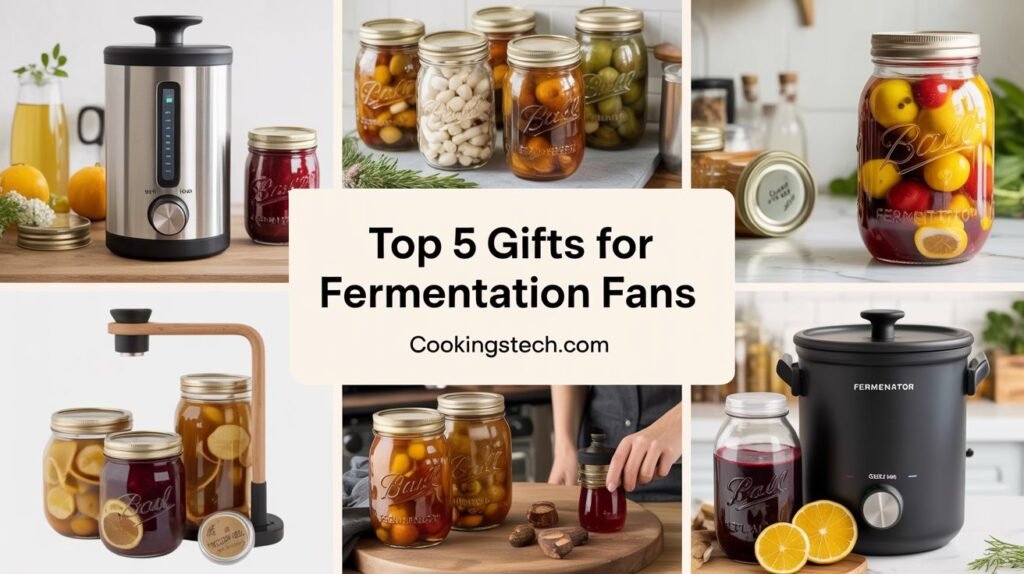
If you’re passionate about fermentation, brewing, or food preservation, finding the right gear and community events can make all the difference. Whether you’re shopping for yourself or searching for the perfect gift ideas for a friend, knowing where to buy trusted equipment and where to connect with fellow enthusiasts is key. Let’s explore some top resources and fun events that bring food preservation fans together.
Trusted Places to Buy Equipment: ProBrewer Classifieds, Stout Tanks, and Portland Kettle Works
For serious homebrewers and small commercial setups, ProBrewer Classifieds is a go-to marketplace. It offers a wide selection of new and used brewing equipment including fermenters, kettles, and accessories. With thousands of listings, you can find everything from small batch fermenters to large-scale tanks. It’s a trusted hub that connects buyers and sellers across the U.S. If you’re upgrading your setup or starting fresh, check out ProBrewer Classifieds regularly for deals on top-quality gear.
Another excellent source is Stout Tanks, a company specializing in high-quality stainless steel fermenters, bright tanks, and brewing vessels. Their products are built to last and designed for optimal temperature control and ease of cleaning—perfect for anyone serious about fermentation.
Don’t miss Portland Kettle Works, known for its customizable brewing equipment tailored for home and commercial brewers. Whether you need a precise brew kettle or a full fermentation system, Portland Kettle Works offers reliable, durable products that meet your needs.
Community and Events: Open Houses, Grape Stomps, and Harvest Dinners
Joining local open houses and festivals is a fantastic way to learn, taste, and connect. Many wineries and breweries host open houses where you can tour facilities, ask questions, and see the latest fermentation tech in action. It’s also a great opportunity to meet other enthusiasts and share tips.
Seasonal grape stomps are fun, hands-on events that celebrate the harvest and offer a taste of tradition. Participating in a grape stomp lets you experience the process that goes into winemaking while enjoying community spirit.
Harvest dinners are another popular event, often hosted by vineyards or breweries. These dinners showcase farm-fresh ingredients paired perfectly with house-made fermented beverages, giving you a full sensory experience of the farm-to-table process.
Gift Ideas for Food Preservation Lovers
Looking for gift ideas for the fermentor or brewer in your life? Consider these popular items available on Amazon that combine practicality with the fun of fermentation:
- Conical Fermenters — Make fermentation cleaner and easier, ideal for homebrew beginners and pros alike.
- Vacuum Sealers — Preserve fermented foods longer by removing air, great for pickles, kimchi, and more.
- Fermentation Crocks and Mason Jar Kits — Classic tools that add charm and efficiency to any fermentation project.
- Smart Temperature Controllers — Keep fermentation at the perfect temperature, ensuring consistent results every time.
Recommended Amazon Products:
🔗 ProBrewer Classifieds Equipment — Browse starter kits and accessories.
🔗 Stout Tanks Fermentation Vessels — Durable, professional-grade fermenters.
🔗 Portland Kettle Works Brew Kettles — High-quality kettles for precision brewing.
🔗 Fermentation Crocks & Mason Jar Kits — Great for beginners and traditionalists alike.
Whether you’re buying gear, attending open houses or grape stomps, or shopping for the perfect gift idea, these resources and events make food preservation more accessible and enjoyable. Dive in and celebrate the art of fermentation with tools and experiences that inspire!
Conclusion: Smarter, Fresher, Tastier Every Day
In today’s fast-paced world, food preservation is more important than ever—not just to reduce waste, but to enjoy fresher, tastier meals every day. Thanks to advances in technology, IoT food preservation tools and smart fermentors have transformed how we store, ferment, and savor our favorite foods and beverages. These innovations make it easier to control fermentation conditions, extend shelf life, and maintain peak freshness—all from the comfort of your own kitchen.
One of the biggest benefits of smart food preservation tools is precision. With connected sensors, control panels, and real-time monitoring apps, you can fine-tune temperature, humidity, and timing for every batch. This level of control leads to more consistent flavors and safer fermentation, helping even beginners create professional-quality results. Whether you’re aging wine in a conical fermenter or vacuum-sealing homemade pickles, technology takes the guesswork out of the process.
Another major advantage is convenience. Instead of constantly checking your fermenting foods or worrying about spoilage, smart tools alert you when conditions need adjusting. This saves time and reduces stress, so you can focus on experimenting with new recipes and flavors. The integration of IoT food preservation tools means you can manage your kitchen remotely, making it simple to keep your foods fresh no matter how busy life gets.
But beyond the technology, the true revolution is in how these tools empower you to reconnect with the art of food preservation. From traditional fermentation to modern vacuum sealing, you’re joining a growing community of people passionate about better food, less waste, and healthier living. Smart fermentors and preservation gadgets invite you to experiment, learn, and enjoy the satisfaction of crafting something truly your own.
So, whether you’re a seasoned fermentor or just starting out, don’t hesitate to embrace these tools. The blend of science and tradition can elevate your kitchen game, making every batch smarter, fresher, and tastier.
In short, the future of food preservation is here—and it’s smarter than ever. By investing in the right food preservation tools, especially IoT food preservation tools, you’re setting yourself up for success, flavor, and fun in the kitchen for years to come.
FAQs-
1. What are the most effective food preservation tools for modern kitchens?
Modern food preservation tools go beyond plastic bags and traditional containers. Today’s kitchens benefit from smart tech like vacuum sealers, IoT Food Preservation Tools, and conical fermenters. Tools such as the mason jar fermentation kit, vacuum chamber systems, and smart freshness trackers help extend shelf life while keeping flavor intact.
2. How do IoT Food Preservation Tools work?
IoT Food Preservation Tools use smart sensors and app connectivity to monitor freshness, humidity, and temperature. From smart fridges that remind you when groceries are expiring to vacuum sealers with freshness alerts, these tools make food preservation more efficient. You can even connect them to a Control Panel for remote monitoring of your entire food storage setup.
3. What’s the difference between traditional and smart fermentors?
Traditional fermentors rely on guesswork. Smart fermentors—like those from Stout Tanks or Portland Kettle Works—offer real-time temperature control, CO₂ release valves, and fermentation data tracking. Whether you’re making fermented vegetables, hot sauces, or kombucha, investing in a conical fermenter with a butterfly valve and rubber stopper ensures safer, tastier results.
4. What’s the best batch size for home brewing and fermentation?
Choosing the right batch size depends on your goals. For beginners, a Brewmaster 5 Gallon Homebrew Starter Kit is ideal—it balances experimentation with manageability. Large batch sizes require more equipment like a Brew Kettle, Mash Tun, Lauter Tun, or Bright Tank, while smaller batches work great in a mason jar setup with smart fermentation lids.
5. What tools help during liquid transfers in fermentation?
For clean and efficient liquid transfers, use transfer tubing with a butterfly valve. These accessories reduce contamination when moving liquids between your conical fermenter and storage containers. Silicone, food-grade tubing is recommended, especially during bottling or transferring brews into a vacuum chamber or secondary fermentor.
6. What is the purpose of White Oak Maturation Sticks in fermentation?
White Oak Maturation Sticks simulate barrel aging by infusing your beverages with deep, rich flavors like vanilla and spice. Made from American White Oak, they’re perfect for small-batch aging in mason jars or Badmotivator Legacy Barrels. They’re reusable, compact, and come with toasting instructions to help you build your ideal flavor profile.
7. Are Badmotivator Legacy Barrels worth it for home brewers?
Absolutely. Badmotivator Legacy Barrels are handcrafted American White Oak barrels designed for enthusiasts who value authenticity. They’re perfect for aging beer, wine, or fiery ferments like hot sauces. You can use them with accessories like White Oak Maturation Sticks or customize the char level based on your desired flavor profile.
8. What are some essential tools for home brewing beyond fermentors?
Besides a conical fermenter, essential home brewing tools include:
- A Brew Kettle with volume markings
- Mash Tun and Lauter Tun for grain processing
- A Wort Chiller for fast cooling
- A Control Panel for temp automation
- A stylish Brewmaster Tap Handle and Tap Board for serving
These tools make home brewing efficient, fun, and flavorful—whether you’re a beginner or launching a Nano Brewery.
9. Where can I find quality fermentation equipment?
Top places include:
🔗 ProBrewer Classifieds — For used brewing gear and accessories
🔗 Stout Tanks — High-end fermentors
🔗 Portland Kettle Works — Custom brew kettles
These suppliers are trusted by Nano Breweries and Willamette Valley vineyards alike.
10. How does the Willamette Valley influence modern food preservation?
The Willamette Valley is home to vineyards like Domaine Roy & Fils, Remy Wines, and Yamhill Valley Vineyards, where traditional wine aging meets smart fermentation tech. Many use American White Oak barrels, temperature sensors, and host events like grape stomps, open houses, and harvest dinners that celebrate this fusion of tradition and innovation.
11. What’s a great gift idea for someone into food preservation or fermentation?
Top gift ideas include:
- White Oak Maturation Sticks for flavor lovers
- A Brewmaster 5 Gallon Homebrew Starter Kit for beginners
- Vacuum Sealers for everyday food storage
- Fermentation Crocks or mason jar kits
- A Tap Board and Brewmaster Tap Handle for home bar setups
These make thoughtful, useful gifts for anyone exploring food preservation or home brewing.
12. How do butchers use food preservation tools like vacuum sealers?
Artisan butchers like Porter Road, The Meat Wagon, and Western Daughters Butcher Shoppe use vacuum sealers, fermentation chambers, and oak flavor chips to cure meats and extend freshness. Vacuum sealers help remove oxygen and preserve flavors in charcuterie, while fermentors maintain safe, consistent fermentation during curing.
Check Our-
